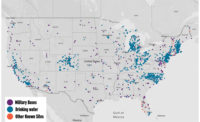Two environmental groups are calling on the Environmental Protection Agency to regulate and require the cleanup of per- and polyfluoroalkyl substances (PFAS) and list them as hazardous substances under the Clean Air Act, the Clean Water Act and the Comprehensive Environmental Response, Compensation, and Liability Act.
“The evidence has become clear that PFAS are our new PCBs—but appear to be more widespread and dangerous,” Erik Olson, senior director at the Natural Resources Defense Council, told members of a House of Representatives Energy and Environment subcommittee during a May 15 hearing on PFAS.
The Environmental Working Group on May 6 proposed a cleanup standard of 1 part per trillion for PFAS after a study discovered that contamination in the U.S. was triple what it was thought to be a year ago. The recommendation is in contrast to the EPA’s April 25 interim recommended clean up standard of 70 ppt for two chemicals in the group: perfluorooctanoic acid and perfluorooctanesulfonic acid. EPA’s recommendation was based on its current scientific understanding of PFAS toxicity, says EPA Administrator Andrew Wheeler.
The environmental advocates also recommended the PFAS group, which contains about 5,000 synthetic fluorinated organic chemicals, be regulated as a class rather than one by one. PFAS, which have been used in cookware, food packaging, stain repellents and fire-fighting foams, have been linked to health issues and cancers.
As of March 2019, at least 610 locations in 43 states were know to be contaminated with PFAS chemicals, including drinking water systems serving about 19 million people, the Social Science Environmental Health Institute in Boston said. The number of known contaminated sites was 172 in July 2018.
Tracy Mehan, with the American Water Works Association, said EPA has made positive steps, but could do more. He suggested the Toxic Substances Control Act and the Safe Drinking Water Act could be used to protect against PFAS contamination.



Post a comment to this article
Report Abusive Comment